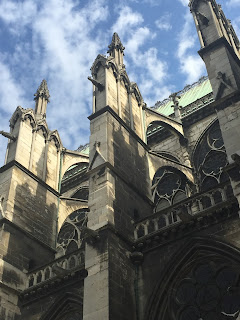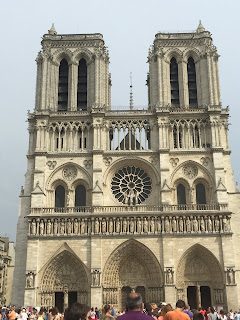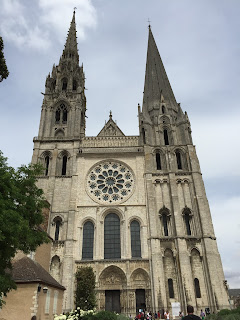Our field trip for Tuesday was to Disneyland Paris. And let me just tell you it was really cool and a bit different from the Disney World we all know. It was a pretty great experience because I really enjoy roller coasters and being with friends. So it was fun to see all the different lands inside. My favorite was probably Discovery Land because Space Mountain was there and so was the Star Wars thing that was pretty cool. My other favorite ride was Tower of Terror that was in Hollywood Studios right next to Disneyland. After we went through both parks we went through the Disney Village to get some shopping done. After all this my feet were exhausted but I'd say we hit everything we wanted to because thankfully Jeanie had our day laid out for us.
So one of the main differences would obviously be the castle. Disney World in Florida features a castle designed for the one and only Cinderella. The castle at Disneyland Paris is one designed for Sleeping Beauty. The guests at the park are also pretty different than that of parks in America. At this park I experienced more older guests than what I remember at Disney World. I didn't really see any small children and they seemed to be having good family time instead of fussing which was really nice. This reflects the French culture to me in the sense that they seem more laid back than most Americans are.
At least one similarity is that there is a statue of Walt Disney incorporated into every Disney park.
But since it's been a good while since I've actually been to Disney World, I don't really have much to go off as far as differences other than the castle. But, luckily I have seen movies that have been set in France and can kind of compare the way France is portrayed in the movies versus what we see at Disneyland. For example, I've seen Beauty and the Beast and in this Disney classic, the main character, Belle lives in a small French town. It's quiet (unless they're breaking out in song) and quaint. People for the most part mind their business and do their work, much like the France I've come to experience. But the town itself has architecture that reminds me of the city off the coast of France called Deauville. But some of the same architecture was mimicked in Disneyland Paris.
So it was really interesting seeing how France decided to portray their version of Disney and how they combine the two worlds into one, and efficiently. The park itself was really lovely and I'd love to go again!
My Trip to Paris
Thursday, July 30, 2015
Wednesday, July 29, 2015
Look at that Street Art
But some other instances of street art include:
 |
| Tiled Space Invaders are popular. |
 |
| Just tagging stuff I guess. |
 |
| Literally art being done on a street, as well as the art on the bridge itself. |
 |
| Stick guy carrying a bar. |
 |
| Even vans have graffiti. |
Sunday, July 26, 2015
Musée d'Orsay
For this field trip, we went to the Orsay Museum, and it was probably my favorite so far. The site itself is an old train station that has been transformed into the home of impressionism style paintings, which seem to be my favorite style. These are some images of the museum itself.
Some of the more famous pieces in this museum belong to names like Van Gogh, Degas, Monet, Manet, Seurat, Gauguin, and Cézanne. Here are some of the more famous paintings that I think we've all heard about along the line.
Two of my favorites of this selection would be Monet's Luncheon on the Grass and Seurat's The Circus. I like these two and for two totally different reasons.
The first one, Luncheon on the Grass (1863) was pretty controversial when it came out, so controversial that it was rejected from the Salon, but then accepted into the Salon des Refusés. It has been said that the woman in the front without clothes on is there for the pleasure of the two men, to put it kindly. And people didn't like seeing that, as it wasn't something that was talked about so out in the open. The lady in the back is for some reason, a lot larger when compared to the people in the front. Logically, if she is further back in space, she should not appear to be the same size as the subjects up front and close to us. Apart from the shocking and confusing subject matter, Manet also strayed away from traditional techniques in the fact that he didn't really blend his colors like most artists had before him. This made the image appear flatter and the colors to appear as shapes. This piece stands out to me because Manet seemed like he had the mindset that he wasn't going to follow the typical rules and regulations to be considered an artist. He painted what he wanted to paint, and how he wanted to paint it. That's why this piece is sometimes considered the painting that started the movement towards Modern Art. I like how this piece stirred up ideas and emotions and started conversation through it's subject matter. Like we talked about in class, I think art is a good middle man to bring up certain otherwise taboo topics.
The second piece is Georges Seurat's The Circus (1890-91). My main reason for liking this particular piece is the fact that the whole image is made of dots, little pieces of color that blend only when coming in contact with eyes. I mean that's what most of art really is, a visual connection. But Seurat managed to figure out how to get the human eye to do most of the work. By applying what is known as the Divisionist theory to his piece, he was able to mix colors optically instead of physically. This allowed him to combine the artistic world with the scientific in that instead of the viewer just looking at a piece and never really going further, the viewer would look at this and try to understand why is it they see this range of colors when they aren't technically there. That is the draw I have towards this piece. It also makes the viewer think about what they are looking at, but in a different way than what Manet accomplished. I guess in a sense, I like both these pieces for the same reason in fact because I like art that requires the viewer to do more than just look. I like pieces that ask the viewer to look deeper than the canvas and interpret what it is they're looking at and why it makes them feel the way they do.
Some of the more famous pieces in this museum belong to names like Van Gogh, Degas, Monet, Manet, Seurat, Gauguin, and Cézanne. Here are some of the more famous paintings that I think we've all heard about along the line.
 |
| Luncheon on the Grass - Edouard Manet |
 |
| Poppy Field - Claude Monet |
 |
| Les glaçons - Claude Monet |
 |
| Mont Sainte-Victoire - Paul Cézanne |
 |
| Bedroom in Arles - Vincent van Gogh |
 |
| The Circus - Georges Seurat |
Two of my favorites of this selection would be Monet's Luncheon on the Grass and Seurat's The Circus. I like these two and for two totally different reasons.
The first one, Luncheon on the Grass (1863) was pretty controversial when it came out, so controversial that it was rejected from the Salon, but then accepted into the Salon des Refusés. It has been said that the woman in the front without clothes on is there for the pleasure of the two men, to put it kindly. And people didn't like seeing that, as it wasn't something that was talked about so out in the open. The lady in the back is for some reason, a lot larger when compared to the people in the front. Logically, if she is further back in space, she should not appear to be the same size as the subjects up front and close to us. Apart from the shocking and confusing subject matter, Manet also strayed away from traditional techniques in the fact that he didn't really blend his colors like most artists had before him. This made the image appear flatter and the colors to appear as shapes. This piece stands out to me because Manet seemed like he had the mindset that he wasn't going to follow the typical rules and regulations to be considered an artist. He painted what he wanted to paint, and how he wanted to paint it. That's why this piece is sometimes considered the painting that started the movement towards Modern Art. I like how this piece stirred up ideas and emotions and started conversation through it's subject matter. Like we talked about in class, I think art is a good middle man to bring up certain otherwise taboo topics.
The second piece is Georges Seurat's The Circus (1890-91). My main reason for liking this particular piece is the fact that the whole image is made of dots, little pieces of color that blend only when coming in contact with eyes. I mean that's what most of art really is, a visual connection. But Seurat managed to figure out how to get the human eye to do most of the work. By applying what is known as the Divisionist theory to his piece, he was able to mix colors optically instead of physically. This allowed him to combine the artistic world with the scientific in that instead of the viewer just looking at a piece and never really going further, the viewer would look at this and try to understand why is it they see this range of colors when they aren't technically there. That is the draw I have towards this piece. It also makes the viewer think about what they are looking at, but in a different way than what Manet accomplished. I guess in a sense, I like both these pieces for the same reason in fact because I like art that requires the viewer to do more than just look. I like pieces that ask the viewer to look deeper than the canvas and interpret what it is they're looking at and why it makes them feel the way they do.
Wednesday, July 22, 2015
Parisian Rides
Sunday, July 19, 2015
Bastille Day!
So let's begin with the history. Bastille Day, which is a holiday celebrated in France on July 14, is a day symbolic of their freedom. To correspond this to an American equivalent, this is France's Independence Day. So the Bastille was a building that was built as a means to protect the citizens of Paris from attacks from the English in 1370. It was later used as a prison for the wealthy and people the king just had a problem with. To the people this prison began to "symbolize the tyranny of the Bourbon monarchs." So mobs began to form when King Louis XVI surrounded Paris with troops and fired Jacques Necker from his position as minister of state, who had supported the reforms. In 1789, the prison was attacked and after a while Bernard-René Jordan de Launay surrendered and the seven prisoners were free to go. King Louis XVI and Marie Antoinette were executed for treason. This was the end of the monarch and the beginning of the French Revolution.
The way Bastille Day is typically celebrated now a days is there is a military parade down the Champs-Elysées, there are Firemens' Galas that you can go to that are one big party. And of course the whole country of France gets ready to celebrate with fireworks. For me and my friends, we happened to be at the Eiffel Tower to watch this go down. Needless to say, it was an experience I won't forget.
In America we traditionally celebrate our Independence Day with grilling out and spending time with our families, and then we also celebrate with fireworks. Our fireworks are nothing like what I witnessed here though. Not only were the fireworks at the Eiffel tower amazing in itself, but France also paid tribute to other nationalities which is something we don't do back home. It was nice to see fireworks that were choreographed to music that represented other groups of people and seeing the people of France take the time to recognize others on their Bastille Day is truly eye opening.
The way Bastille Day is typically celebrated now a days is there is a military parade down the Champs-Elysées, there are Firemens' Galas that you can go to that are one big party. And of course the whole country of France gets ready to celebrate with fireworks. For me and my friends, we happened to be at the Eiffel Tower to watch this go down. Needless to say, it was an experience I won't forget.
 |
| We got there at 9am to find the perfect spot. |
 |
| Good thing we did, because we soon got swarmed. |
 |
| The neat part was hearing the French people sing their national anthem. |
 |
| Night time starts to fall and it's about to begin. |
 |
| And it was spectacular! |
Wednesday, July 15, 2015
Paris Fashion
Sunday, July 12, 2015
Flying Buttresses Galore
For our second field trip we went to Basilica of Saint-Denis, the very first Gothic Cathedral. I enjoyed this trip because the cathedral we went to wasn't filled with tourists and it was a little out of the way in a nice little town. Other Gothic cathedrals that I have seen while in France include Notre Dame, Sainte Chapelle, and the Chartres Cathedral. All the pictures below are from those cathedrals.
Around 250 CE, Saint Denis, the bishop of Paris was martyred and buried. Abbot Suger rebuilt parts of the Saint-Denis in the 12th century, and it was completed in 1144. This is when the Gothic style was created. The goal of Gothic architecture was to let in light because light was equated with God and they were built as tall as possible in order to be close to God. This was achieved through flying buttresses and ribbed vaulted arches. The flying buttress allowed support and weight distribution. The ribbed vaulted arches provided weight distribution on the inside walls and allowed for structures to be built taller.
Another less structural characteristic is rose windows that are at the end of the nave and usually also the transepts. The rose window typically tells a story of the Bible through stain glass. I just really like the way they look and the purpose they serve.
Around 250 CE, Saint Denis, the bishop of Paris was martyred and buried. Abbot Suger rebuilt parts of the Saint-Denis in the 12th century, and it was completed in 1144. This is when the Gothic style was created. The goal of Gothic architecture was to let in light because light was equated with God and they were built as tall as possible in order to be close to God. This was achieved through flying buttresses and ribbed vaulted arches. The flying buttress allowed support and weight distribution. The ribbed vaulted arches provided weight distribution on the inside walls and allowed for structures to be built taller.
 |
| Ribbed Vaulted Arches - Saint-Denis |
 |
| Flying Buttresses - Saint-Denis |
 |
| Rose Window - Saint-Denis |
 |
| The face of Saint-Denis |
 |
| Inside one area of Saint-Denis |
 |
| Inside of Sainte Chapelle |
 |
| Notre Dame |
 |
| Chartres Cathedral |
 |
| Flying Buttresses! - Chartres Cathedral |
Subscribe to:
Comments (Atom)






















